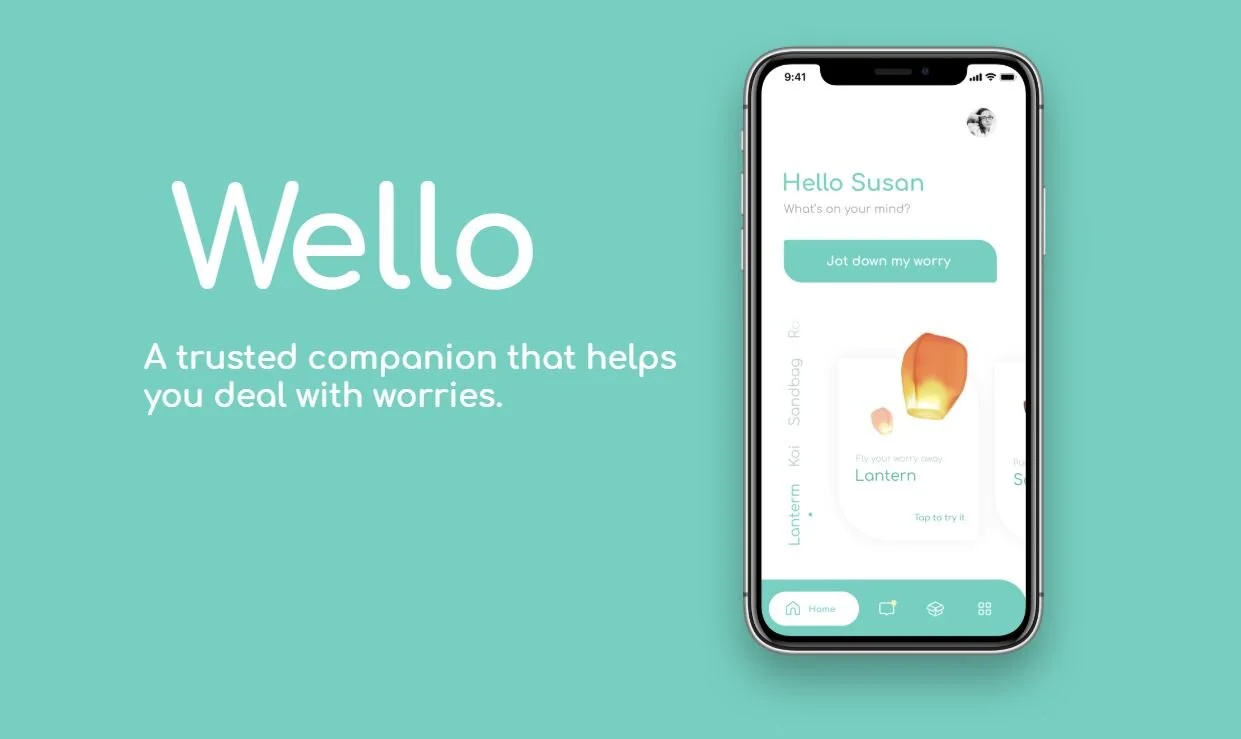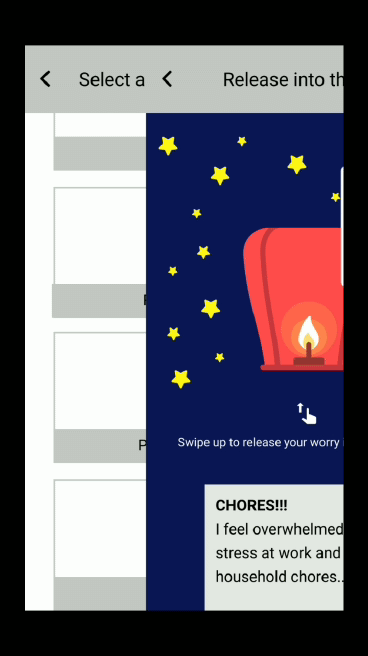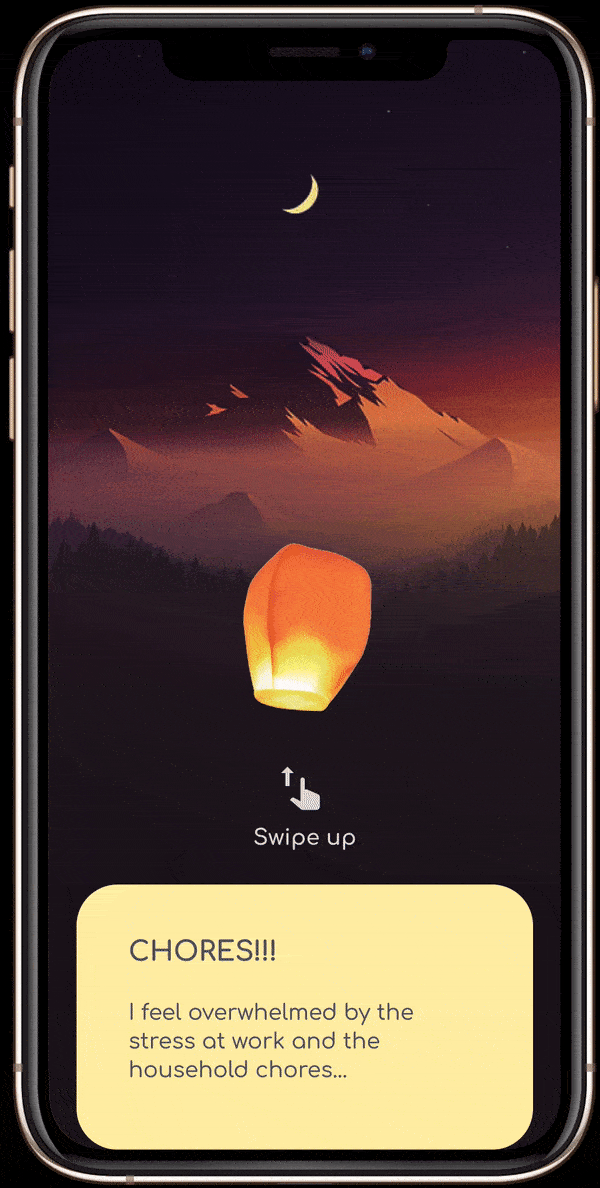
Wello
A trusted companion that helps you deal with your worries.

Project Purpose
Helping people deal with worries and negative thinking through the process of thought disposal.
The A Team
Rachel Lee, Huiqin Gao, Honson Ling, Freda Hu
Project Outcome
A gamified iOS mobile application that helps users to deal with their worries in different, immersive ways.
Project Duration
This project was completed over the course of 10 weeks as part of a graduate course in User Centered Design.
Project Overview

The topic of mental health is something our team was passionate about and as someone who suffers from anxiety and depression, I was eager to explore this design space. The initial goal of our project was to figure out how we could help working professional women improve their mental health and with three of our group members identifying as female, we believed that we could bring perspective and empathy to this topic.
Initial Design Question
We began with a broad design question focusing on the mental well-being of professional women.
“How might we help working professional women improve their mental well-being?”
However, as our user research progressed, we realized that we would need to adjust our design questions to focus on a specific need of a wider range of users. More on this later.
User Research
Our team conducted four types of user research to explore and define the problem space and to help us empathize with our target users: working professional women. These methods included surveys, user interviews, card-sorting, and secondary research.
Survey
I was tasked with the responsibility of creating the survey which our team first deployed via Google Forms to various women in our network. The purpose of the survey was to get an idea of the various trends and perceptions across our target users within a relatively short amount of time. Due to the sensitive nature of the topic of mental health, I designed the survey to be relatable and unobtrusive. Some items were drawn from the Perceived Stress Scale, a widely used scale for clinical stress research.
We received 21 responses and the majority of responses were from women between the ages of 18-34 with various professional backgrounds.
The survey results gave us many helpful insights about our target audience’s contexts, behaviors, and frustrations. To summarize a few of our findings:
more than 60% of all participants reported “often” or “fairly often” feeling anxious, depressed, and/or sad.
meditation, exercise, and talking to friends seemed to be the most popular form of dealing with negative emotions
76% of participants had not sought mental healthcare in the recent past because they were either too busy, that mental healthcare was too expensive, or that they did not feel the need for mental healthcare at this time
User Interviews
To probe further, we conducted five user interviews with working women aged 22 to 32 with different cultural and professional backgrounds. Based on the participants’ availability and preference, we talked with them either face-to-face or online. Based on the participants’ availability and preference, we talked with them face-to-face or online. Even though the interviews were conducted by different researchers, we developed a general interview structure applied across all interviews. Our interviews incorporated IDEO’s 51 Methods including “Foreign Correspondent” and “Five Whys”.
Our interviews provided us with more valuable insights about our target users. At a high-level, these users aspire to gain a sense of achievement, a sense of control and recognition of their value. Their frustrations mainly come from unhealthy interaction with other people, and the loss of balance when juggling between self-care, life, and work. As a behavior pattern, they find it particularly helpful to talk to a trustworthy person (close friends, therapists) and having someone backing them up.
Card Sorting
After gathering initial exploratory insights from surveys and interviews, we conducted a card sort to put ourselves in the user's shoes—this helped us to align our understanding of our target user's mental models about their core values, high-level needs and drives when it comes to maintaining mental health wellness.
The card sorting process was completed in three steps. In the first step, our team identified user's key values from previous research using brainstorming and affinity mapping with post-it notes. In the second step, we conducted a card sorting study on Optimal Workshop. Lastly, we analyzed the card sorting responses, and voted for the top-one value our minimum viable product (MVP) is going to primarily focus on.
The results of the card sorting are valid and reliable because we collected a significant size of responses (47 valid, from the United States) and eliminated bias by diversifying the audience (on various demographic dimensions, including location, profession, age, etc.). The card sorting results are summarized in the similarity matrix shown below.

Card Generation

Card Sorting Results
Secondary Research
Our fourth research method was utilizing secondary research as a way to further understand our users needs, mental health, and potential design solutions for intervention. We retrieved articles from valid sources (such as the American Psychological Association, as well as academic journals) on topics such as the mental health of women, stress reduction digital activities, and art therapy.
One particularly interesting and enlightening research paper was on the topic of Thought Disposal as a method for reducing stress in teens. This study was conducted by Elin Bjorling at the University of Washington. This paper would later be critical in the inspiration behind our final design solution.
User Persona
Based on the findings in our user research, we created our primary persona Susan to stay anchored to our user’s needs as we moved through the design process.
Meet Susan

A single woman in her 30s, working as an accountant. She is currently struggling with anxiety and desires to have more confidence and a sense of balance in her life. She is busy because of her job and she feels her social circle is shrinking as she gets older. She doesn’t always feel like she can reach out to her friends about her worries and anxieties.
Redefining the Scope and Design Question
Our initial design question:
“How might we help working professional women improve their mental well-being?”
helped to form the direction of our research.
Focusing on this initial question, our user research from surveys, interviews, and card sorting activity revealed three areas that were essential for mental wellness in women:
1) People often struggle to find meaning and purpose in their lives.
2) People often feel frustrated while trying to stay motivated and in control of their goals and personal struggles.
3) People have difficulty finding connection and often feel alone when dealing with when dealing with personal struggles.
These frustrations and difficulties manifest into worries and anxieties that affect overall mental well-being. Our users need help in processing and overcoming these negative thoughts and feelings in order to attain better mental health.
Our team felt that, as a whole, these themes were not exclusive to working professional women. So we decided that we should focus on helping anyone deal with their negative emotions in a healthy and reflective way.
As such we modified our Design Question into:
“How might we help people deal with negative emotions?”
Ideation

Our team spent two sessions brainstorming and sketching features and ideas for our design solution. Our original brainstorming session produced 24 sketches and our team voted on the ideas that we thought should be in the Wello design.

Identify goals and frustrations

Sharing worries with friends

Disposing of worries into a fire (inspired by thought disposal)
Prototyping
Our team built a mid-fidelity prototype of the Wello iOS mobile app with the prototyping tool Figma. The original mid-fidelity prototype had a Log-in, Home Screen, Writing Down Worries, Saving Worries in a Box, Sending Worries to a Friend, Burning Worries in a Fire, and an Achievements Page. Transitions were assigned to specific interactions to make the prototype clickable and ready for initial usability testing.
Usability Testing
We conducted moderated in-person usability testing on our mid-fidelity prototype with five users.

Testing done on a touch screen laptop

From our usability test, we discovered several issues with our prototype namely the navigation and functionality of our Home Screen (a catastrophe) and a flawed Achievements system. These were later fixed and improve upon in future iterations of our prototype.
We received overwhelmingly positive feedback from our participants and from classmates for the “Burn Your Worries” function of the Wello app. This function was inspired by Thought Disposal methods used in the Bjorling study with teens to ease stress.

Mid-Fidelity prototype of "Burn your worry" feature. Users reported enjoying the animation of the worry being crumpled and thrown into the fire and receiving an uplifting quote at the end of the interaction.
We decided to add additional ways of “dealing with worries” other than burning them. We ideated five additional methods, made some much needed updates to increase the usability of our prototype (especially our home screen) and conducted further testing.
Into the Night Sky
Each group member was tasked with adding a new method for “dealing with worries”. I was tasked with designing an interaction where a user attaches a worry to a lantern and releases it into the night sky.
I was particularly proud of this interaction and how it turned out in both the mid-fidelity and final prototype.

Design
As part of our final deliverable, we outlined and elaborated on the project background, key features, app navigation, user flow and visual design details with a design specification document. I was responsible for drafting and editing this document and including annotated visuals.
See our detailed design specification here.
Information Architecture

This map shows the overall content structure and information hierarchy of the application.
Visual Design
In our final design, we incorporated all of our knowledge gained from previous iterations and user testing, as well as a developed visual design specification for a coherent high-fidelity prototype.

Wello Key Features
Writing & Sketching Out Worries
Our research indicated that taking the time to thoughtfully write down worries and subsequently sketch them out were helpful in relieving the burdens of negative thinking.

Interactive Modes for Dealing with Worries
Our research and subsequent testing showed that users found “disposing” of their worries to be enjoyable, helpful and cathartic. As such, we focused on various “modes” of dealing with worries.



Worry Sharing
Our research showed that users felt better after talking to friends about their problems and worries. User testing of earlier versions showed that some users were wary of the possibility of negative triggers when sharing heavy worries. As such, we included elements of rating worries from light to serious.

Memory Box
Users can return to and reflect upon old worries saved in the Memory Box. Users can see how they dealt with specific worries in the past and can reflect on how to overcome other worries in their life.

Next Steps
Conduct additional user testing on high-fidelity prototype
Research and Ideation into a Wello VR Solution
Continue iterating on design
Reflection
I was so proud of the work that my team and I did on this project. I think we created a design solution that is truly meaningful, delightful, and unique. Each team member contributed equally in each step of the design process and I honestly enjoyed working with my every member of my team.
One of my main takeaways from this project was that you must always check your assumptions about the users and to test early and often. I also learned that you must be flexible and be ready to pivot to a new design direction when necessary. I appreciated that nobody on my team was too invested in certain design decisions. When it became clear that we needed to make a shift in our design, we were all on board and were able to move forward quickly.
This project will remain in my memory as one of the most fulfilling and creative projects I have ever worked on. There are discussions for possibly getting the team back together and making this our Capstone!

Team HmmForReal at our showcase